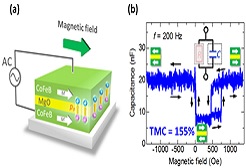Hideo Kaiju
Hokkaido University, Japan
Title: Large tunnel magnetocapacitance in magnetic tunnel junctions
Biography
Biography: Hideo Kaiju
Abstract
Spintronics is an emerging research field which utilizes the charge and spin degrees of freedom of electrons in solid-state systems and devices. One of the most successful devices in spintronics is the magnetic tunnel junction (MTJ), which consists of two ferromagnetic layers separated by a thin insulator. MTJs show a large tunnel magnetoresistance (TMR) effect at room temperature [Nat. Mater. 3, 868 (2004)]. At present, the TMR ratio has reached up to 600% in MTJs with MgO tunnel barriers [Appl. Phys. Lett. 93, 082508 (2008)]. On the other hand, MTJs also exhibit tunnel magnetocapacitance (TMC) effect at room temperature [J. Appl. Phys. 91, 7430 (2002), Appl. Phys. Lett. 90, 142105 (2007)]. Recently, we have observed a large TMC ratio beyond 150%, which is three times larger than the conventional value, at room temperature in MTJs with MgO tunnel barriers [Appl. Phys. Lett. 107, 132405 (2015)]. We have also found that the mechanism of TMC effect can be well explained by the theoretical calculation based on Debye- Fröhlich model. This calculation predicts that the TMC ratio can be as large as about 1000% for a spin polarization of 87%, while the TMR ratio is 623% for the same spin polarization. These theoretical and experimental findings provide a deeper understanding on AC spin-dependent transport in MTJs and will open up wider opportunities for device applications, such as highly sensitive magnetic sensors and impedance-tunable devices. Furthermore, MC effect has also been observed in molecular spin valves [SPIN 4, 1440015 (2014)], magnetic nanoscale granular solids [Nat. Commun. 5, 4417 (2014)], and magnetic single electron transistors [Sci. Rep. 5, 13704 (2015)]. Rapid progress is now being made in the research field on MC effect. In this talk, we focus on MC effect in spintronic devices and present the recent progress in this field.

Recent Publications
- T. Misawa, S. Mori, T. Komine, M. Fujioka, J. Nishii, and H. Kaiju, Appl. Surf. Sci. 390, 666 (2016).
- H. Kaiju, M. Takei, T. Misawa, T. Nagahama, J. Nishii, and G. Xiao, Appl. Phys. Lett. 107, 132405 (2015).
- H. Kaiju, H. Kasa, T. Komine, S. Mori, T. Misawa, T. Abe, and J. Nishii, J. Appl. Phys. 117, 17C738 (2015).
- H. Kaiju, Y. Yoshida, S. Watanabe, K. Kondo, A. Ishibashi, and K. Yoshimi, J. Appl. Phys. 115, 17B901 (2014).
- Y. Yoshida, K. Oosawa, S. Watanabe, H. Kaiju, K. Kondo, A. Ishibashi, and K. Yoshimi, Appl. Phys. Lett. 102, 183109 (2013).

